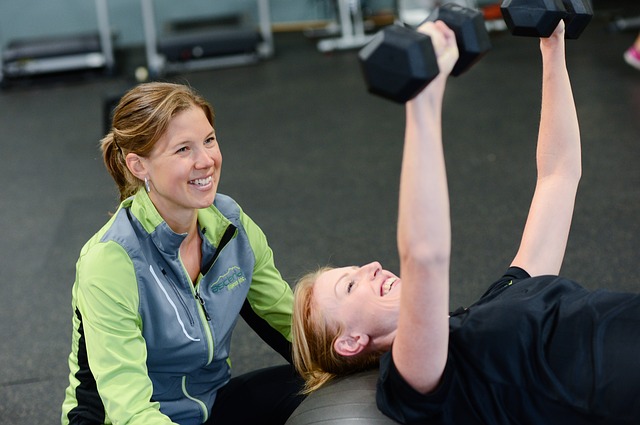Money-back guarantees are great for customers. What’s the risk? Don’t like the product, get your money back. Don’t like the service, get your money back…
Businesses that offer money-back guarantees also win: landing an otherwise hesitant customer gives you a chance to prove yourself…and if your products or services are great, what’s the risk?
But in some industries, like fitness and weight loss, offering a money-back guarantee can seem pretty foolish–yet that’s exactly what New York City-based Halevy Life does with its Fitness Guaranteed program. (And maybe that’s why they’re the only gym that actually guarantees results.)
The offer? Simple: If, at the end of 90 days, a client hasn’t improved in at least three of five quantifiable fitness measures, they get their money back.
Sounds crazy at first. Pretend you’re a personal trainer: You can provide your clients with diet and nutrition advice…but you can’t control whether they follow it. You can give your clients “homework” to do outside the gym…but you can’t control whether they actually do it. All you can control is what they do when they are with you…and that time is a fraction of the total hours in a 90-day period.
So Halevy Life founder Jeff Halevy took a smart approach to a money-back guarantee–one that works for his clients as well as for his business.
“It’s one of those things that always bothered me about the industry: Someone invests money, they work with a fitness pro, and it’s always turned around on them if they don’t get results. The trainer has no accountability.”
Here’s how it works. First they establish eligibility requirements. Clients must commit to working with one of Halevy’s coaches three times a week for 90 days…and must attend 85 percent of their sessions. (It’s hard to help people improve if you can’t actually help them improve.)
Then each new client takes five quantitative fitness measurements using initial assessments for:
Lean Body Mass. But they don’t use calipers. (That’s a good thing; if you’ve ever had someone measure your body fat using calipers you know how uncomfortable and even creepy it feels.) Instead they purchased a hydrostatic tank that provides clinical-grade numbers (and eliminates the creepy factor).
As Jeff says, “We’re not into fluff. We’re running an evidence-based and research-based practice, so we need numbers. We need to measure and defend what we do quantitatively.”
Fat Mass. Same principle. Same tank.
Strength. Jeff measures movements that are indicative of total body strength–core exercises like bench press, squat, and dead lift. While those aren’t the only way to assess strength, they do encompass major body movements and are a great gauge of where a client is…and where that client can go.
Cardiopulmonary Fitness. Halevy measures heart-rate recovery. Here’s how it works.
Exercise until you reach your heart-rate max (one common way to determine heart rate max is 225 minus your age)
Once you reach your max, stop exercising and pedal or walk slowly
Measure your heart rate for the next two minutes
People who are in relatively good shape will see their heart rate drop fairly quickly, with heart rates dropping thirty beats per minute or so in the first minute alone. People in relatively poor shape will not recover quickly at all. (Think of it this way: A heart in good condition is a reactive heart.)
Halevy uses other methods to assess cardio fitness, this is just one of them. (But I really like this one; it’s one of the ways I measure my cardio fitness.)
Movement Capacity. Movement capacity involves mobility and flexibility.
According to Jeff, flexibility is only the measure of the length of a muscle and doesn’t indicate much about how people perform in real life or whether it helps enhance athletic performance. Movement capacity is a tie-in of mobility (range of motion of a muscle) and flexibility.
“We go through a number of orthopedic tests that determine these things,” Jeff says, “and then we also use the functional movement screen, a screening protocol that was created and is the gold standard at the pro and collegiate level of determining an athlete’s readiness for sports…and anyone’s readiness for movement.”
Then what happens? Clients work with a trainer. Clients can take advantage of the advice of an in-house dietician.
Most importantly, because clients have committed to showing up, they put in the work–and that’s where the money-back guarantee starts to make sense.
“We want you here,” Jeff says. “Even if you’re not in Fitness Guaranteed, we will only take you on as a private client if you commit to working with us for three months at least two times a week. We can’t deliver for you if we can’t work with you.”
And that’s why it works. Say I’m a client and I decide I won’t take Jeff’s diet and nutrition advice. In fact, I eat even more than I did before I started. That’s OK–as long as I work out three times a week for 90 days, Jeff’s program ensures I’ll gain strength, gain flexibility, I’ll improve my cardio fitness level…if I put in the work, those things will happen.
And that means Jeff has met the terms of his guarantee.
And that also means that seeing improvement will motivate me to keep going, keep improving…and probably start to change my eating habits. The satisfaction of achieving one level of success spurs you on to reach the next level…and the next…and the next.
BOTTOM LINE: Improvement creates an awesome feedback loop that sparks further improvement. This is a win-win and a great learning lesson for business owners looking to kick start things. If you’ve never tried a money-back guarantee because it seems too risky–especially if it’s hard for you to influence, much less control, customer behaviors and usage–what guarantees could you put in place using a similar model?
To receive similar content, “Like” us on Facebook @ https://www.facebook.com/niagarabuzz.ca












